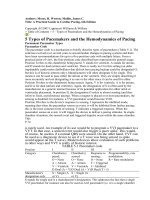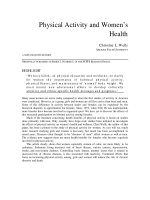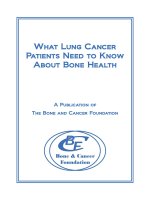UNDERSTANDING AND LEARNING ABOUT STUDENT HEALTH pptx
Bạn đang xem bản rút gọn của tài liệu. Xem và tải ngay bản đầy đủ của tài liệu tại đây (249.49 KB, 8 trang )
Teacher Workshop
Curriculum
UNDERSTANDING
AND LEARNING
ABOUT STUDENT
HEALTH
Written by Meg Sullivan, MD with help from Marina
Catallozzi, MD, Pam Haller MDiv, MPH, and Erica
Gibson, MD
UNDERSTANDING AND LEARNING
ABOUT STUDENTS’ HEALTH
Teacher Workshop Curriculum Outline:
Goal: To increase teachers’ comfort with common topics of adolescent health and
improve the interaction between the school and the School Based Health Clinic (SBHC.)
Workshop Four: Reproductive Health—What Role Does a Teacher Play?
Brief review of puberty, normal timelines for males and females
Demographics of sexual activity, STIs in Washington Heights
Role of teachers in addressing reproductive health
Role of SBHC, medical providers in addressing reproductive health
Lesson Plan: Reproductive Health:
What Role Does A Teacher Play?
Goal: To review normal puberty, discuss sexual activity and sexually transmitted
infections in adolescents, and to discuss the role of teachers and the SBHC in addressing
reproductive health.
Introduction: Brief introduction of yourself and teachers. Briefly review lesson plan
outline. (5 minutes)
Warm up: Adolescents and Sexual Activity: Do You Agree? Inform the teachers you
are going to read a series of statements. Teachers should raise their hands if they agree
with the statement. (5 minutes)
Key points
* Issues of reproductive health will come up in the schools
* Even if students are not sexually active (which most are not), they are
still impacted by the topic.
*Important for teachers to reflect on and discuss their own
feelings/opinions about reproductive health so they can better address the
issues that arise.
Puberty—Normal Timelines for girls and boys (10 minutes) Handout: Puberty—
Quick Overview.
Key points
*Puberty onset occurs at different times for males and females
*Wide range of puberty onset among each gender—important teenagers
know they are “normal”
*Growth spurts and body changes can lead to “awkward” appearances
*Increased sweating/body odor raises issues of hygiene
Sexual Activity and Teenagers: Quick Facts (10 minutes)
Key points
*Significant percentage of teenagers sexually active; this number increases
most during high school
*Majority of adolescents report using contraception, but still significant
number that do not.
*Adolescents account for 50% of diagnoses of STIs
*Significant number of adolescents have not been tested for STIs
Role of School in Addressing Reproductive Health (10 minutes)
Key points
*Minors are entitled to confidential reproductive health care in NYS
*SBHC provides many of these services to which minors are entitled
*Teachers should understand pubertal changes and sexual issues facing
teenagers today and know where to refer.
Questions (5 minutes)
Adolescents and Sexual Activity: Do You Agree?
This activity is designed to begin the discussion of puberty and sexual activity in
adolescents by asking teachers to think about and share their opinions on specific
questions related to this topic. Read each question aloud and ask teachers to raise their
hands if they agree.
1. Students should be taught about normal puberty.
Agree
Disagree
2. Students should be taught sexual education.
Agree
Disagree
3. Students are entitled to confidential reproductive health care (i.e. without parents
knowing).
Agree
Disagree
4. Having confidential access to contraception makes students more likely to have
sex.
Agree
Disagree
5. Students are more likely to use reproductive health care services if they know it is
confidential.
Agree
Disagree
6. If a student is noted to have poor hygiene (i.e. body odor), it is the teacher’s
responsibility to talk to him/her about hygiene.
Agree
Disagree
7. If a student asks a teacher a question about sex, the teacher should discuss it with
him/her?
Agree
Disagree
8. Most students in the school are having or have had sexual intercourse.
Agree
Disagree
Puberty: Quick Overview
Puberty is when hormonal changes in your body result in changes in physical and sexual
characteristics, making you capable of reproduction.
Females:
o Usually start puberty between ages 8 and 13 (average age is 10.5 years)
o Some girls start pubertal changes as early as 6 or 7 (obesity can be a
contributing factor in earlier onset)
o Breast development occurs first, followed by hair growth
o Menstruation occurs 2 to 2.5 years after puberty starts (10.5-16.5 years.)
o Other changes include
§ Growth spurt, widening of hips, increased body fat
§ Increased sweating and body odor, resulting in need to wear deodorant
§ Acne
1
Males:
o Usually start puberty between ages 10 and 14 (average age is 11.5-12
years)
o Initial change is enlargement of testes/scrotum followed by penile
enlargement, pubic hair development, and facial/ axillary hair
development
o Other changes include
§ Growth spurt, increased muscle mass
§ Increased sweating and body odor, resulting in need to wear deodorant
§ Acne
§ Nocturnal emissions (“wet dreams,”) increased erections
§ Voice changing (cracking, then becoming deeper)
1
Sexual Activity in Adolescents: Quick Facts
Initiation of Sexual Activity:
v Approximately 10-15% of middle school students report having engaged in sexual
activity
v 47% of 9-12
th
graders report having sexual intercourse (33% 9
th
graders, 62% 12
th
graders)
3
v The median age at first intercourse is 17.4 years old for females and 16.9 years
old for males
3
v 13% of girls and 15% of boys report initiating sexual intercourse prior to age 15
1
v 10% of girls report that their first intercourse was non-voluntary
1
1
2
Contraception Use
1
:
v 75% teenage girls and 82% teenage boys used some method of contraception
during their first intercourse
v 98% of sexually active girls have used at least one type of birth control
v Condoms are the most common method of birth control, followed by oral
contraceptive pills
v FEW teenagers use protection against BOTH pregnancy and STIs
v The older a teenage girl is at initiation of intercourse, the more likely she is to use
contraception
v Approximately 2/3 of teenagers reported receiving some education on methods of
birth control
v A sexually active female who is not using contraception has a 90% chance of
becoming pregnant within one year
4
1
2
3
4
www.nyc.gov/html/doh/ html/pr2007/pr075-07.shtml
Sexual Activity in Adolescents: Quick Facts
Sexually Transmitted Infections (STIs)
v There are approximately 9 million new cases of STIs among adolescents (15-24
year olds) each year. This represents almost one half of the total new cases of
STIs.
1
v Human papillomavirus (HPV) accounts for approximately 50% of the STIs.
Certain types of HPV cause cervical cancer and genital warts.
(There is a new vaccine called Gardasil against the 4 most common types of HPV
that cause cervical cancer and genital warts).
v Chlamydia is the most common bacterial STI among teenagers. Up to ¾ of males
and ½ of females do not have symptoms of infection; therefore routine screening
of sexually active teenagers is important.
v Gonorrhea is another common bacterial STI. Up to 90% of females do not have
symptoms on infection.
v Untreated chlamydia or gonorrhea can cause pelvic inflammatory disease (PID)
and/or infertility with repeated infections or if not treated.
(Symptoms of PID can include abdominal pain, vaginal discharge, fever, painful
urination, pain with intercourse, irregular menstrual bleeding).
2
2
v Having an STI makes an individual two to five times more likely to acquire HIV
if exposed via sexual contact than those not infected with an STI.
v Approximately 13% of new HIV diagnoses each year are made in people under
the age of 25.
v In New York City, the number of 13-19 year olds infected with HIV increased
29% between 2004 and 2006.
3
v Only approximately 30% of teenagers under the age of 18 report having been
tested for STIs.
1
2
3
Gonorrhea — Age-specific rates among women
15 to 44 years of age: United States, 1997–2006
What is the Role of the School in
Reproductive Health?
Teenagers’ Rights:
• In New York State, any minor “who
understands the risks, benefits, and
proposed alternatives to certain health
services" has the right to confidential
reproductive health care.”
• This includes the right to obtain the
following services without parental consent
or notification:
- Contraceptive counseling and care
- Emergency contraception
- Pregnancy testing
- Abortion
- STI testing and treatment
(including HIV testing)
• Information pertaining to reproductive
health in a minor’s medical record cannot be
disclosed without the minor’s consent.
School Based Health Clinics
What Reproductive Health Care Services Do They Offer?
(This may depend on whether you are in a Middle School or a High School)
• General Reproductive Health Care
• General Reproductive Health Education
• Contraceptive counseling and referrals as needed
• Contraception—condoms, oral contraceptive pills, Depo-Provera, etc.
• Emergency contraception
• Pregnancy testing
• STI testing
• STI treatment
• PAP Smears and referrals for abnormal PAPs
What is the Role of Teachers?
• Important to be aware of pubertal changes students are experiencing and be prepared to
address hygiene issues (since the teacher sees the student daily, this is less embarrassing
for the student rather than referring them to someone they do not know).
• Also important to be aware of choices students are confronted with and are
making with regard to sexual activity.
• Many teachers will be approached by students with questions regarding puberty
and/or sexual activity.
• If a teacher doesn’t feel comfortable discussing these issues, he/she should know
where to refer the student.









